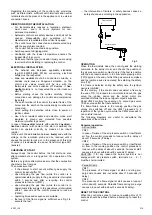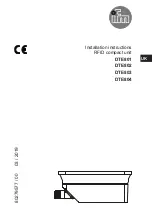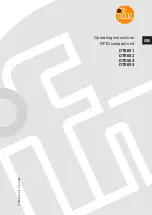
Regarding the connection of the control units, provisions
such as strain reliefs, sufficient earth terminals and neutral
terminals should be present in the appliance or in external
connection boxes.
DIRECTIONS FOR THE INSTALLATION
−
For technical-safety reasons a regulation shutdown
must occur every 24 hours (systems for non-
permanent operation).
−
Automatic controls are safety devices and shall not be
opened.
Responsibility
and
guarantee
of
the
manufacturer is invalidated if the control is opened.
−
The control must be connected and disconnected only
with the supply disconnected.
−
The control can be mounted in any position.
−
Avoid exposure to dripping water.
−
Ventilation with the lowest temperature ensures the
longest life of the control.
−
Make sure that the type (code and times) you are using
is correct before installing or replacing the control.
ELECTRICAL INSTALLATION
−
The national and European applicable standards
(e.g.EN 60335/1prEN 50165) concerning electrical
safety must be respected.
−
Live
and
neutral
should be connected correctly, a
mistake could cause a dangerous situation, i.e. the
control and valves would still be live with the
thermostats and limits switched off. Besides, if
live-
neutral
polarity is not respected the control locks out
after TS.
−
Before starting check the cables carefully. Wrong
connections can damage the control and compromise
the safety.
−
The earth terminal of the control, the metal frame of the
burner and the earth on the mains supply must be well
connected.
−
Avoid putting the detection cable close to power or
ignition cables.
−
Use a heat resistant cable and detection probe, well
insulated to ground and protected from possible
moisture (or water in general).
In case of
live-neutral
network with unearthed
neutral
or
live-live
network (with center of the star not earthed) the
control can operate correctly by means of an inbuilt
resistor.
In the event of bad insulation between
live(s)
and earth the
voltage on the ionization probe can be reduced until it
causes the control to lock-out. In the presence of this kind
of network it is advisable to use our transformer type AR1
(booster).
CHECKING AT START
Always check the control before the first start and also
after amendments or a long period of no operation of the
system.
Before any ignition attempt make sure that the combustion
chamber is free from gas.
Then make sure that:
−
if the attempt to start occurs without gas supply the
control locks out after TS;
−
when stopping the gas flow (while the control is in
operational state) supply to the gas valve is interrupted
within 1 second and, after a recycling, the control
proceeds to lock-out (VM41);
−
when stopping the gas flow (while the control is in
operational state) supply to the gas valves is interrupted
within 1 second and the control proceeds to lock-out
(VM42);
−
operating times and sequence are suitable;
−
the level of the flame signal is sufficient, see Fig.3 to
execute the test;
−
the intervention of limiters or safety devices causes a
safety shut-down according to the application.
Fig.4
OPERATION
When the thermostats close, the control gives the starting
command to the burner motor and checks the position of
the air pressure switch contacts; only if the test is positive
with the air pressure switch in “air flow” state prepurge time
(TW) begins, at the end of which the gas valve is energized
and the ignition device is operated, thus starting the safety
time (TS).
If a flame is detected during the safety time the ignition
device is inhibited.
On the contrary, if the control does not detect a flame by
the end of TS, it proceeds to non-volatile lock-out, the gas
valve, the ignition device and the burner motor are
switched off while the lock-out signal output is supplied.
Model VM42 controls the opening of a second gas valve
15-20 seconds after the flame detection.
If a flame failure occurs in the running position the gas
valves are switched off and the VM41 proceeds to a
repetition of the ignition cycle, while the VM42 proceeds to
non-volatile lock-out.
The following diagrams are useful to understand the
operations of the controls.
Abnormal operation
- Air flow failure
VM41:
In case of failure of the air pressure switch or insufficient
air flow the control proceeds to lock-out with a delay of
about 15 seconds (t1 delay).
VM42:
In case of failure of the air pressure switch or insufficient
air flow in the running position the control proceeds to
lock-out with a delay of about 3 seconds. Air lack at start
causes a lock-out within about 8 seconds (t1 delay).
CAUTION: If for any reason the burner system is not
equipped with air pressure switch, terminals n.4 - 6 - 7
must be short-circuited.
- Parasitic flame
VM41:
The presence of a flame signal at start or during pre-
purge time causes lock-out within about 15 seconds (t2
delay).
VM42:
The presence of a flame signal at start causes a lock-out
within about 8 seconds. Parasitic flame during pre-purge
causes a lock-out within about 3 seconds (t2 delay).
RESET OF THE CONTROL
When the control has gone to lock-out a waiting time of 10
seconds should be allowed before attempting to reset the
control.
Control unit
8
Detection probe
4007_r00 3/4






















